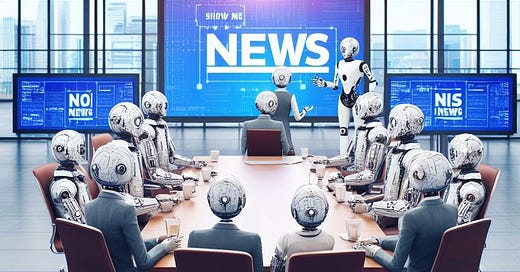Welcome to The Media Copilot
There are plenty of newsletters about AI. This is the one about how it's changing the media.
In the past year, artificial intelligence in media — how content is generated, consumed, and scaled — has gone from curiosity to, it seems, inevitability.
It's no exaggeration to say the effect of ChatGPT's public debut was seismic. Using AI to create publishable content had previously been the domain of well-resourced media companies like Reuters or The Washington Post. Now anyone with an internet connection could prompt a chatbot to write articles instantaneously.
The promise of machine-generated content proved dangerously irresistible, and much of the early "dabbling" into generative AI (or GenAI) quickly rubbed against the limits of the technology as a content generator. Many publishers consequently developed a cautious approach to AI. However, several others have pressed forward to integrate GenAI into content strategy, leveraging machine-driven content for service journalism, markets coverage, and lots more. By the day, AI feels less like a tool and more like a force of nature — something everyone in the media business will need to adapt to eventually.
Here to Help
Guidance is clearly required, and that's what this newsletter aims to provide. Through daily insights and weekly conversations with smart people, The Media Copilot will unpack the "how" of AI's role in media.
I’m under no illusions here — there are a lot of AI newsletters. That’s why I’m narrowly focused on how AI is changing newsrooms and the roles within them. But even within that subspace, it’ll be helpful to note what I’ll be focusing on and what I won’t.
I’m not a product designer or engineer (though some are my best friends), so you won’t get deep dives on the ins and outs of specific large language models or the importance of UX. That said, it'd be hard to talk about AI tools in the newsroom without discussing their features. Plus there are ways that AI may fundamentally shift the product-editorial relationship, something I find fascinating and definitely have plans to explore.
I’m also not the AI police. There are plenty of good journalists uncovering stories about the mistakes various publishers are making in applying generative AI. The world doesn’t need one more. I’ll certainly be commenting on some of these stories to inform my thoughts on the best practices in media surrounding these tools, but my focus is on what successful application of AI looks like in media and the news, which is potentially much more far-reaching than a few hallucinations.
And that's a good transition to what will be the North Star for The Media Copilot: the application. Not just the nitty-gritty of how media companies are using AI, but also what those companies look like on the other side: How are jobs lost, created, or changed? How does it affect distribution, KPIs, and even business models? And what are the things about generative AI that every writer and editor needs to know?
As newsrooms all over the world figure out how to leverage the power of generative AI in effective and ethical ways, I intend to zero in on where the rubber hits the road: the tools they're using, the ways they're integrating generative content into their offerings, and the brand-new reader experiences AI is making possible.
Most of all, I plan to examine how the growing presence of AI in newsrooms is changing what it means to be a journalist.
About the Author
Why should you listen to me? Well, you shouldn't, at least until I've told you something useful, which I'll aim to do every day. But here's a little bit about where I'm coming from:
I've been fascinated with the rise of AI over the last decade. I've been a technology journalist for more than 20 years, with front-row seats to Big Tech's many forays into the power of algorithms, whether it was Google's digital assistant making calls to hair salons on your behalf or Amazon's big push into your home via Alexa and its accompanying hardware. I have a good eye for where hype ends and reality begins, and I intend to bring that "realistic" view to what I write about here.
At the same time, I don't intend to indulge in knee-jerk cynicism. AI clearly has transformative potential, and genies have a tough time fitting back into bottles. Far better to look for ways the tech can help with what it does well than to overindex on the damage it can cause from the things it doesn't. In either case, it's the human decisions that the consequences stem from.
That's the attitude I took when I approached generative AI as Chief of Staff at CoinDesk. There, I led an internal AI Committee to explore the ways AI could be applied to content generation. I authored the publication's extensive guidelines on the use of GenAI and spearheaded several internal teams to prototype various use cases. The exercise gave me both an appreciation for how to shape strategy around the power of AI as well as plenty of hands-on experience with tools.
My plan is to send a daily newsletter about a specific topic or trend, with weekly conversations with innovators, thought leaders, and decision makers who are building the bridges between AI and the media. The daily newsletter will stay free, though I plan to take the weekly conversations into a paid tier at some point. In time, I hope to serve up even more (human-generated) content.
And I can't do this alone. If you have ideas for stories to pursue, people to interview, or just random thoughts about AI in the media, please share them! Comment on this post, or you can reach me at pete@petepachal.com.
Now let's go define the future before it defines us.





Love this. And congrats! Lfg
Perfect timing. Thank you!